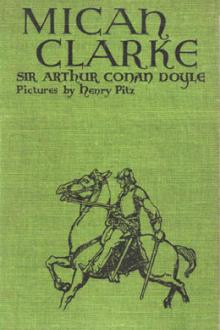Three Thousand Years of Mental Healing, George Barton Cutten [crime books to read TXT] 📗

- Author: George Barton Cutten
- Performer: -
Book online «Three Thousand Years of Mental Healing, George Barton Cutten [crime books to read TXT] 📗». Author George Barton Cutten
Pettigrew makes the following enumeration which shows the division of labor among the saints in the Middle Ages. In this, not the different portions of the body but the various diseases and infirmities are distributed.
"The following list, though doubtless very imperfect, will yet serve to show how general was the appropriation of particular diseases to the Roman Catholic saints:
St. Agatha, against sore breasts.
St. Agnan and St. Tignan, against scald head.
St. Anthony, against inflammations.
St. Apollonia, against toothache.
St. Avertin, against lunacy.
St. Benedict, against the stone, and also for poisons.
St. Blaise, against the quinsey, bones sticking in the throat, etc.
St. Christopher and St. Mark, against sudden death.
St. Clara, against sore eyes.
St. Erasmus, against the colic.
St. Eutrope, against dropsy.
St. Genow and St. Maur, against the gout.
St. Germanus, against diseases of children.
St. Giles and St. Hyacinth, against sterility.
St. Herbert, against hydrophobia.
St. Job and St. Fiage, against syphilis.
St. John, against epilepsy and poison.
St. Lawrence, against diseases of the back and shoulders.
St. Liberius, against the stone and fistula.
St. Maine, against the scab.
St. Margaret and St. Edine, against danger in parturition.
St. Martin, against the itch.
St. Marus, against palsy and convulsions.
St. Otilia and St. Juliana, against sore eyes and
the headache.
St. Pernel, against the ague.
St. Petronilla, St. Apollonia, and St. Lucy, against the toothache.
----, and St. Genevieve, against fevers.
St. Phaire, against hemorrhoids.
St. Quintan, against coughs.
St. Rochus, and St. Sebastian, against the plague.
St. Romanus, against demoniacal possession.
St. Ruffin, against madness.
St. Sigismund, against fevers and agues.
St. Valentine, against epilepsy.
St. Venise, against chlorosis.
St. Vitus, against madness and poisons.
St. Wallia and St. Wallery, against the stone.
St. Wolfgang, against lameness."32
Wax from the tapers illuminating the altar which enclosed St. Gall's mortal remains was an instantaneous cure for toothache, diseased eyes, and total deafness; a vase used by the martyred Willabrod for bathing thrice a year, still holding its partially solidified water by divine invocation after her death, had great remedial energy in diverse ailments; the water in which the ring of St. Remigius was immersed cured certain obstinate fevers; and the wine in which the bones of the saints were washed restored imbeciles to instant health. In the thirteenth century, hairs of saints, especially of St. Boniface, were used as a purge, and a single hair from the beard of St. Vincent, placed about the neck of an idiot, restored normal mental operations. With the water in which St. Sulpicius washed her hands aggravated infirmities were instantly cured; and in the twelfth century, an invalid being advised in a dream to drink the water in which St. Bernard washed his hands, the Abbot of Clairvaux went to him, gave him the wash water, and healed an incurable disease. Flowers reposing on the tomb of a saint, when steeped in water, were supposed to be especially efficacious in various diseases, and those blooming in aromatic beauty at the tomb of St. Bernard instantly cured grievous sicknesses.33 The belt of St. Guthlac, and the belt of St. Thomas of Lancaster, were sovereign remedies for the headache, whilst the penknife and boots of Archbishop Becket, and a piece of his shirt, were found most admirably to aid parturition. Fragments of the veil of the saintess Coleta, and the use of her well-worn cloak, immediately cured a terrible luxation, and a cataleptic patient was restored to sanity by drinking from her cup.
To show how thoroughly the idea of the efficacy of these relics must have been indued in the thought of the times, White quotes the following: "Two lazy beggars, one blind, the other lame, try to avoid the relics of St. Martin, borne about in procession, so that they may not be healed and lose their claim to alms. The blind man takes the lame man on his shoulders to guide him, but they are caught in the crowd and healed against their will." He also says: "Even as late as 1784 we find certain authorities in Bavaria ordering that anyone bitten by a mad dog shall at once put up prayers at the shrine of St. Hubert, and not waste his time in any attempts at medical or surgical cure."34
In addition to what Dr. White says here about the treatment for threatened hydrophobia in the eighteenth century, we find a curious mixture of science and superstition in the nineteenth century in connection with the same trouble. Early in this century physicians discovered that the most effectual remedy against the bite of a rabid animal was the cauterization of the wound with a red-hot iron. In Tuscany, however, the iron which they heated was one of the nails of the true cross, and in the French provinces it was the key of St. Hubert. This, though, was only to be used in the hands of those who could trace their genealogy to this noble saint. At the abbey of St. Hubert, in the diocese of Liege, the intercession of the saint still continued to be sufficient to effect a cure, provided it was seconded by some religious ceremonies, and a diet which would reassure the patient.
After the discovery of the "true cross," portions of this relic were much used for aid in any emergency. In addition to sanitary and healing powers, fragments suspended to a tree manifested the proper location of sacred edifices. St. Magnus, who seems to have carried pieces around with him, completely vanquished demons who frequented a locality selected for a chapel. Eyesight was restored to a humble merchant seeking the blood-stained marks upon the chapel of this same St. Magnus. The blind man was feeling his uncertain way to the place, where these discolorations reappeared more distinctly after each washing with heavy layers of lime.
St. Louis, almost in the agonies of earthly dissolution, with rigid body, rigorous limbs, and fluctu ating spirit, was brought to full health by the application to his moribund body of a piece of the true cross, about the year 1244; and later in the century miracles took place at his tomb. M. Littré, in his Fragment de Medecine Rétrospective, describes seven miracles which occurred at his tomb, some of which cures, however, were very gradual. We are also told that when a humble hunchback bowed the knee in adoration at the tomb of St. Andreas, his irresistible faith instantly released him from his unnatural rotundity. In 1243 a Ferrara writer was at Padua, and while attending vespers at the tomb where the sainted body of the Minorite Anthony reposed, he affirms that he saw a person who had been mute from his birth recover his voice and speak audibly.
Saintly remedies were used to cure hemorrhages, readjust luxations, unite fractures, remove calculi, moderate the agonizing pangs of parturition, restore vision to the blind, and hearing to the deaf—in fact, in an endeavor to perform cures which modern medicine and surgery are counting among their greatest and most recent triumphs. Some things even more strange were attempted: paradoxical as it may seem, they were used to cover up crime. Fort tells us that among nuns and consecrated women in convents, some erring sisters applied the preventive talismanic influence of a sacred shirt or girdle to suppress the manifestation of conventual irregularities of a sexual character. Animals as well as human beings were treated for sickness, and relics were used to free captive birds and animals. At a banquet, a costly urn was shattered by ecclesiastics, and through the power of Odilo it was restored to its original integrity. At the tombs of both St. Severin and St. Gall, when the light had been quenched, miraculous fire burst forth to renew the splendor.35
The allotment of certain diseases to certain saints did not end with the Middle Ages. I have in my hand a little manual entitled: De l'Invocation miraculeuse des Saints dans les maladies et les besoins particuliers, par Mme. la Baronne d'Avout, published in 1884. An invocation is given for every day in the year to some particular saint, who is thought to be especially efficacious in the cure of some specific disease. I shall quote but one for illustration.
"30 MAI
S. HUBERT DE BRÉTIGNY
Près Noyons (Oise).
Honoré au diocèse de Beauvais.
"L'illustre saint Hubert, apôtre des Ardennes, fut son protecteur et lui donna son nom. Il lui obtint les plus heureuses dispositions pour la vertu. Lui aussi hérita du pouvoir de guérir de la rage.
"Les habitants de Noyon et des environs n'ont pas cessé de recourir à son intercession. Les per sonnes qui touchent ses reliques ou portent sur elles son nom béni espérent échapper pendant leur vie aux atteintes des démons, de la rage et du tonnerre.
"À Aire, diocèse de Fréjus, on invoque aussi sainte Quitère contre la rage.
INVOCATION
"Dieu tout-puissant, qui avez formé le cœur de vos saints avec une admirable bonté, afin qu'ils deviennent pour nous une source de bienfaits et de consolation; assistez-nous dans le pressant besoin où nous nous trouvons et sauvez-nous de la mort, par les prières at les mérites de saint Hubert de Brétigny, afin que nous puissions vous louer et vous bénir. Par N.-S. J.-C. Ainsi soit-il."
"Saint Hubert, qui préservez de la morsure des bêtes enragées, ou qui guérissez leur morsures mortelles, priez pour tous les affligés qui vous invoquent."
While there was probably some advance when the saints of the church took the place of the zodiacal constellations in the government of the human body, the church prevented the development along scientific lines, although there were many ramifications of saintly influence. Not the least among these was the healing efficacy of holy wells, pools, and streams, which had been empowered in some way by the saints. In some cases the bones of holy men have been buried in different parts of the continent, and after a certain lapse of time, water was said to have oozed from them, which soon formed a spring and cured all the diseases of the faithful.
Perhaps the cure of leprous Naaman by bathing in the Jordan, and the restoration of the sight of the blind man by washing in the Pool of Siloam may have served as examples which the credulous were only too ready to follow. We must also note, however, as a reason for their use, that in classical times the greater number of thermal waters, more frequently used then than in the present day, remained consecrated to the gods, to Apollo, to Æsculapius, and, above all, to Hercules, who was named Iatricos, or the able physician. At any rate, many wells and fountains were dedicated to different saints, and various rites were performed there at Easter and other particular days, where offerings were also made to the saints.
In Ireland, many such sacred places have been visited by the sick for centuries, and England and Scotland have them also. Not only in the British Isles, but in all parts of Europe they were much frequented in the Middle Ages, and they are not without their visitors to-day. As late as 1805 the eminent Roman Catholic prelate, Dr. John Milner, gave a detailed account of a miraculous cure performed at a sacred well in Flintshire. Gregory of Tours was one of the first to notice the healing power of springs in connection with the saints. He asserted that the diseases of the sick and infirm





Comments (0)